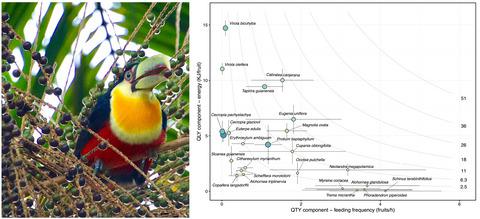Our official English website, www.x-mol.net, welcomes your
feedback! (Note: you will need to create a separate account there.)
Fruit resource provisioning for avian frugivores: The overlooked side of effectiveness in seed dispersal mutualisms
Journal of Ecology ( IF 5.3 ) Pub Date : 2020-01-08 , DOI: 10.1111/1365-2745.13352 Elena Quintero 1 , Marco A. Pizo 2 , Pedro Jordano 1
中文翻译:

为鸟类节食者提供水果资源:种子传播共生中有效性被忽视的一面
更新日期:2020-01-08
Journal of Ecology ( IF 5.3 ) Pub Date : 2020-01-08 , DOI: 10.1111/1365-2745.13352 Elena Quintero 1 , Marco A. Pizo 2 , Pedro Jordano 1
Affiliation

|
- Mutualistic interactions between frugivorous birds and fleshy‐fruited plants are key processes for both natural plant regeneration and the maintenance of birds relying on fruit resources. However, seed dispersal effectiveness (SDE) has been frequently studied only from the plant's perspective, that is the contribution of animals to plant fitness.
- Using a sample of Atlantic rainforest avian frugivores, this study presents a first comparative, empirical study of fruit effectiveness as a nutritional food resource for seed‐dispersing birds through the use of resource‐provisioning effectiveness (RPE) models. RPE is the product of the amount of fruits a frugivore can consume (quantity component) and the quality of the ingesta in terms of energy and nutrients obtained (quality component).
- Our results show wide variation in RPE among fleshy‐fruited plant species. Energy‐rich fruits consistently show a smaller quantity component, while energetically poor fruits are consistently the most consumed, with fruit species spanning a gradient from these two extremes.
- The specific RPEi resulting from a pairwise fruit–frugivore interaction is positively correlated with the total RPE (RPET) that a given fruit species has for the whole frugivore assemblage. RPE therefore appears to be a characteristic feature of the fruit species, rather than of the specific frugivore partner.
- Only the fruit's specific energy content showed a significant phylogenetic signal, suggesting potential constraints for free covariation between RPE and SDE of fruits and frugivores.
- Synthesis . We analyse variation in the effectiveness of fleshy‐fruit food provisioning to avian frugivores by explicitly redefining RPE within the SDE framework. We found ample variation in RPE among plant species, showing differences in both quantity and quality components of fruit resources rewards for the frugivores. Our findings help unravel how seed‐dispersing birds may discriminate among alternative fruit resources and to understand the configuration of mutual dependencies among mutualistic partners.
中文翻译:

为鸟类节食者提供水果资源:种子传播共生中有效性被忽视的一面
- 食肉类鸟类与果肉植物之间的相互影响是天然植物再生和依靠水果资源维持鸟类的关键过程。但是,仅从植物的角度对种子散布效果(SDE)进行了频繁的研究,即动物对植物适应性的贡献。
- 本研究以大西洋雨林鸟类节食动物为样本,通过资源配置有效性(RPE)模型,对水果有效性作为种子分散鸟类的营养食品资源进行了首次比较性,实证研究。RPE是指食肉动物可以食用的水果量(数量成分)与摄入的能量和营养素(质量成分)的质量的乘积。
- 我们的结果表明,在果肉类植物中,RPE差异很大。能量高的水果始终显示较少的数量成分,而能量差的水果始终是消耗最多的水果,水果种类跨越这两个极端。
- 水果与节食动物成对相互作用产生的特定RPE i与给定水果种类在整个节食动物组合中的总RPE(RPE T)正相关。因此,RPE似乎是水果种类的特征,而不是特定的节食动物伴侣。
- 仅水果的比能含量显示出显着的系统发生信号,表明水果和节食动物的RPE和SDE之间自由协变的潜在限制。
- 综合。通过在SDE框架内明确重新定义RPE,我们分析了肉果食品对禽类食肉动物供应的有效性差异。我们发现植物物种之间的RPE差异很大,表明果肉的果实资源数量和质量成分的差异对果蝇具有奖励作用。我们的发现有助于揭示散种鸟类如何在替代水果资源之间进行区分,以及了解互惠伙伴之间相互依存的配置。











































 京公网安备 11010802027423号
京公网安备 11010802027423号